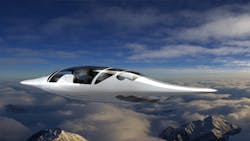This hydrogen-powered flying saucer could be your electric taxi in five years
BERLIN - Emerging aircraft design has been focused on the electric vertical takeoff and landing (eVTOL) segment. Using electric engines powered by batteries, the aircraft are quiet and maneuverable, with the ability to take off and land from anywhere. Their Achilles heel is limited battery capacity. Most have a limited range and operating time, so the eVTOL is being developed for the urban air-taxi market. While advances in battery technology are ongoing, breakthroughs tend to be incremental rather than revolutionary, reports Michael Verdon for Robb Report. Continue reading original article.
The Intelligent Aerospace take:
June 8, 2020 -Among eVTOL commercial aircraft, Electrofluidsytems recently revealed concept aims to utilize both batteries and hydrogen fuel cells to push the range out to about 625 miles at a speed of approximately 155 mph.
Dubbed the H2PlasmaRay has a wingspan around 22 feet, and propels two occupants upward with 10 fans, while an additional 38 fans push the aircraft forward.
“The use of liquid hydrogen is the real breakthrough here,” Berkant Göksel, company founder, told Robb Report. “Our first version will have a speed of approximately 155 mph and range of about 625 miles. That translates to a one-way trip between Berlin and London. We expect the next generation to reach about 190 mph, with a range of about 800 miles.”
Related: Rolls-Royce unveils five passenger EVTOL concept
Related: Urban Air Mobility already has 200 eVTOL designs
Related: State of the game: The key players in the emerging eVTOL air taxi market
Jamie Whitney, Associate Editor
Intelligent Aerospace
